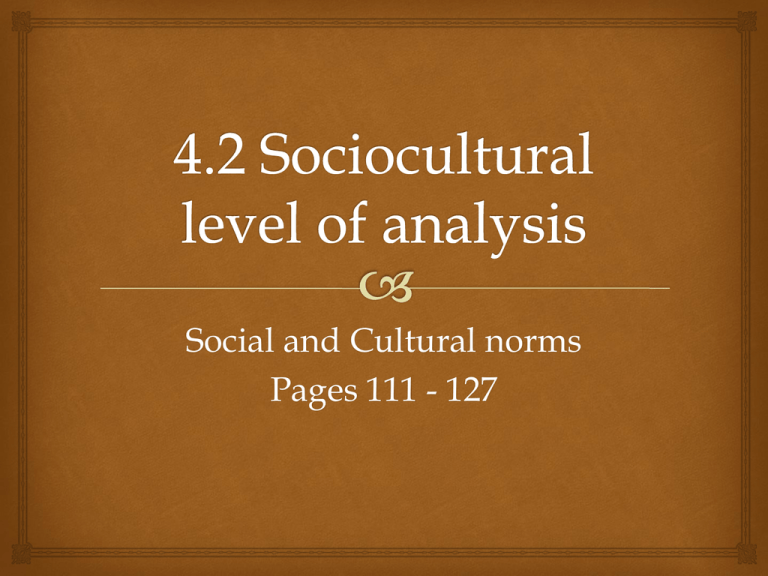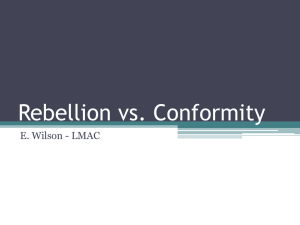
Social and Cultural norms
Pages 111 - 127
Introduction
Norms
A set of rules based on social an cultural beliefs that
regulate behavior
Deviation from the norm results in
punishments, stigmatizing, marginalizing
OR (+) creative, original thinkers
How does the need to belong (social nature of
humans) affect behaviors within the norms?
Reference two studies
Pg 111 - 115
Key Studies & Theories
Bandura's Bashing Bobo study (pg 112-113)
Eron & Huesmann's (1986) study of violence and
television viewing (pg 114)
Kimball & Zabrack (1986) on television and violence in a
Canadian village (pg 114)
Sabido method (pg 115)
*Aronson and Mills (1959) – hazing (pg 119)
Asch - conformity (pg 120) *Abrams (1990) of the Asch
Deutsch and Gerald (1955) conformity (pg 122)
Berry (1967) conformity (pg 123)
Social Learning Theory
Albert Bandura’s, Social Learning Theory
Humans learn behavior through observation and
imitating.
attention
Retention
Social
Learning
Motivation
Motor
reproduction
Observational learning:
Learning that occurs through watching the behavior of
other people.
This is a highly efficient way of learning because we
do not have to actually have the experience ourselves
in order to learn it.
Models may be
direct (teacher to a student) or
Indirect (not trying to influence behavior)
Key Concepts- Bandura
Factors that are involved in social learning
Attention
Retention
Motor reproduction
Motivation – learners must want to demonstrate the
behavior.
Factors that influence whether
social learning will take place
Consistency
Identification with the model.
There is a tendency to imitate those you identify with,
like age, gender,
Rewards/punishment
People learn by what happens to others, you do not
have to experience the consequence.
Liking the model
Warm and friendly models are more likely to be
imitated than cold, uncaring models.
Rewards/punishment
Vicarious reinforcement:
When you learn by watching someone else either receive a reward or
punishment.
Vicarious reward would be when you see someone get a scholarship to a
top US university because of their good grades and extra-curricular actives
and then you become more committed to your school work.
Vicarious punishment is when you watch someone put their hand in a
pool of hot water and get burned; you learn not to do the same thing even
without having to be burned yourself.
Bandura et al. 1961
Aim:
would children imitate aggressive adult models?
Were children more likely to imitate same sex models?
Method: experimental
Procedure:
Children ages 3 – 6 were grouped according to a defined
aggression rating.
Each group was exposed to a different modeling behavior
After viewing the models, children were observed in a
natural environments and assessed
Bandura et al. 1961 cont.,
Findings:
Children showed
signs of observational
learning
Girls imitated verbal
abuse observed by
female model whereas
boys imitated physical
abuse as observed by
the made model
Criticisms of Bandura
Method:
low ecological validity
very brief encounter with the model
the children may have been frustrated when they were
taken away from the toys.
Does aggression against BoBo assume aggression against
living being?
There may have been slight differences in the adult models
aggressive behavior
Initial aggression assessment (grouping) may not have been
accurate
Demand characteristics?
Criticisms of Bandura cont.,
Ethics:
Is it appropriate to demonstrate violence to children?
Is there any guarantee that once violence is learned
that you can unlearn it?
Violence in the media and its
effect on aggression in children.
Social learning theory has been used to explain the
role of violence in the media on aggression in
children.
Application of
social learning theory
The results of televised violence demonstrates
consistently:
Children learn how to be aggressive in new ways
Children draw conclusions as to whether the behavior will
bring rewards or punishments.
Eron (1986), 15 year longitudinal study
Positive correlation between number of hours violence
watched on TV by elementary school children and levels of
aggression when they were teenagers.
Those who watched violence on TV at 8 years of age, were
more likely to be arrested and prosecuted for criminal acts
as adults.
Kimball and Zabrack (1986)
Canadian study – children demonstrated a
significantly higher level of aggression two years after
TV was introduced to the town.
Charlton, Gunter & Hannan (2002),
The other side of the argument
Aim: Does exposure to TV violence influence
behavior?
Method: Natural Experiment
TV was first introduced to St. Helena in 1995
Procedure: cameras were et up in the play grounds
of primary schools and children were observed (ages
3-8) before and after the introduction of TV.
Findings: no significant difference in behavior after 5
year assessment
Why are Charlton et al.
Findings so different?
What might be different about St. Helena vs. the UK
or USA?
Discuss possible reasons as to why this study is so
different from Bandura et al, and Kimball and
Zabrack
Is TV always negative?
Bandura’s Social learning theory is the basis for
educational presentation or shows designed to bring
aware to difficult social issues
Example – Tanzania 1996 – 1996 the serial Twende na
Wakati (Let’s Go with the Times) found an increase in
safe sex
women's status and
family planning.
Sabido Method
Sabido method:
A methodology for designing and producing serialized dramas
on radio and television that can affect change of behavior in the
general population with regard to important social issues, such
as HIV infection, domestic violence and drug use.
Evaluation of Social
Learning Theory
Social Learning Theory explains:
Why behavior may be passed down in families
Why children do not have to use “trial-and-error”
learning to model a behavior.
Note: a behavior may be acquired, i.e. it is not learned
by demonstration.
It does not explain why people do not learn a desired
behavior.
people are motivated not only by modeling, but by
beliefs and previous experiences
Pages 116 - 119
Social Influence: Compliance
Compliance – the result of direct pressure to
respond to a request, even though the pressure may
not be apparent to the individual.
Conformity – when the situation does not exert
direct pressure to follow the majority, BUT, the
pressure is perceived.
Compliance Techniques
Compliance techniques are the cornerstone of marketing
and advertising.
Robert Cialdini:
Six factors that influence compliance
Authority – advertisers use famous people
Commitment – once you comply there is a high likelihood
of repeat behavior.
Liking – people comply with request from people they like!
Reciprocity – the need to return a favor.
Scarcity – “limited quantity,” “limited time,” opportunity
seems more valuable.
Social Proof – got to be right if others are doing it??????
Reciprocity
Reciprocity (pg 116-117)
Reciprocity principle – the social norm that we
should treat others the way they treat us.
The rules of reciprocity state that a person must try to
repay another for their gestures.
What role does guilt play in reciprocity?
Do the emotions involved with reciprocity always
have to involve a tangible exchange of goods? i.e. gift
giving?
Door-in-the-face technique
Door-in-the-face technique – a version of reciprocity
in which emotions are used to elicit the “guilt” that
brings about the exchange of favors.
People are more likely to accept the 2nd request
The tecnique requires 2 requests
First request will surely be turned down, because of the
extreme
The second request is of lesser demand.
Door-in-the-face technique
Cialdini et al.(1975) – posing as a ‘county youth
counselling program.’
Control group:
“Would you be willing to take a group of juvenile
delinquents to the zoo for the day?”
83% refused
Experimental Group:
“would you be willing to sign up for two hours per week as
a counselor for two years?”
All refused
“would you be willing to take a group of juvenile
delinquents to the zoo for the day?”
50% agreed (a 33% improvement)
Door-in-the-face technique
Where are is Door-in-the-face techniques used?
Sales techniques
Manipulation
Commitment (pg 118-119)
Commitment = being consistent with previous
behavior.
Cialdini argues that once a person makes a
commitment they will encounter personal and
interpersonal pressures to follow through.
Kurt Lewin (1951) argued that behavior is motivated
by goal gradients.
The longer people commit to something the less likely
they are to abandon the goal.
Foot in the Door techniques
Foot in the Door techniques
Getting people to agree to something small with the
hopes of persuading them to agree to something
larger
Dickerson et al., (1992)
Aim: could the team get college students to conserve
water in the dormitory showers?
Method: Field Experiment
Procedure: “Foot in the door” technique
1. students were asked to sign a poster:
“take shorter showers. If I can do it, so can you”
2. then they were asked to take a survey to think
about their own water usage.
3. Shower times were then monitored.
Dickerson et al., cont.,
Results: students who signed the poster and had
time to think about their usage had average shower
times of 3.5 minutes. Significantly shorter than
average times across the dorms.
Conclusion: getting people to make a commitment
to something small may influence them to accept a
higher level commitment.
Concerns of this study: maybe those who signed
already have a commitment to the cause?????
Low-balling
A persuasion and selling technique in which an item
or service is offered at a low price, but the cost (price,
time, commitment) is actually higher.
Cialdini et al., (1974) pg 118 example
Hazing
Hazing – a series of initiations in order to join an
exclusive groups.
How dies hazing compare to other initiation rites
seen in other cultures?
Why does this behavior continue?
Why does an individual subject themselves to the
hazing?
Young, 1963, studied 54 tribal cultures: the more
dramatic or stringent the ceremony the greater the
solidarity of the groups
Can group solidarity be
created without hazing?
Aronson and Mills (1959)
Aim: will someone who had to go through the hazing
value the group more that someone who did not have to
go through the hazing?
Method: Experiment
Procedure:
female college students were asked tp join a sex discussion
group
Some had to go through a very embarrassing initiation to
join while others joined without initiation.
Group meeting consisted of confederates who were trained
to be as boring and uninterested as possible and the
participants.
Can group solidarity be created
without hazing? Cont.,
Results:
the women who went through the initiation found the
meeting to be very valuable.
The women who did not have any initiation
recognized that the meetings were “worthless and
uninteresting.”
Social Influence
Summary of techniques
Reciprocity
Door-in-the-face
Commitment
Goal gradients
Foot-in-the-door
Low-balling
hazing
Pages 119 - 123
Social Influence: Conformity
Conformity: the tendency to adjust ones thoughts,
feelings or behaviors in ways that are in agreement
with a particular individual or group.
“peer pressure” is an example of conformity at a
school level.
Classic study of Conformity
Asch (1951)
Aim: to what extent would a person conform to an
incorrect answer on a test if the response from the
other members of the group was unanimous.
Method: Experimental
Procedure:
Confederates – helped the researcher deceive the
participant.
Group was told they would be taking part in a
psychology experiment on visual judgment
Asch’s line test
18 trial were run in all.
Confederates were instructed to
answer some of the trial
correctly, but the majority of
them incorrectly.
Result:
75% agreed with confederates
incorrect responses at least
once.
32% agreed with the incorrect
responses a minimum of onehalf or more trials.
24% did not conform.
Why Did They Conform?
Debriefing notes revealed:
They new their response was incorrect but they did
went along with the group because they did not
want to discredit the results of the test, or appear to
be against the group.
Some felt a sense of unease or self-doubt about their
answer.
Factors that influence the
“Asch Paradigm”
Group Size:
1 confederate = 3%conformity
2 confederates = 14% conformity
3 confederates = 32% conformity
Larger groups did not increase – in case cases they may
even decrese.
Unanimity:
When all confederates agreed, conformity was fairly certain
Confidence
:
If the test is measuring something in a persons field of
expertise, conformant is less likely.
Self-esteem:
Those with high self-esteem are less likely to conform.
A Critical Look at Asch
Artificiality and ecological validity???
Do these experiments accurately predict how people will react in
real-life situations?
Demand Characteristics
Culture
In the original study only one culture was studies and the group
was not multicultural
Ethical Considerations
Deception, feelings of anxiety about their performance today this
would not be regarded as acceptable
Friend et al. (1990) there is a bias in the interpretations. Argues
what factors caused people to dissent rather than influence to
conform.
Can a Minority Opinion
Sway the Majority?
Hogg an Vaughan (1995), reasons a minority can
influence the majority:
Dissenting opinions produce uncertainty and doubt
Such opinions show that that alternatives exist
Consistency show that there is a commitment to the
alternative view.
Examples:
Women’s rights to vote,
Civil rights movement,
environmental protection.
Groupthink – is characterized by having complete
unanimity among the group.
Often the group is blindsided and unprepared for
alternative possibilities.
AVOID GROUPTHINK
Brainstorm
Look at alternatives
Play devils advocate
Why do People Conform?
Deutsch and Gerard
(1955)
Informational social
influence – how people
cognitively process
information about a
situation.
Normative social
influence – people have
the need to belong. They
conform to avoid
rejection.
“I realize this looks
silly, but I want to hang
with these guys.”
Why do People Conform? Cont.,
Festinger (1954)– “Social comparison”: What is
everybody else doing??
When we notice there is a difference and it creates an
anxiety, Festinger refers to this as Cognitive dissonance.
Cultural Aspects of Conformity
True or False:
Asian cultures engage in more conforming behavior and
value conformity to a greater degree than Americans.
True
Americans see conformity as a negative trait.
True
Cashmore and Goodnow (1986) high level of conformity
among Italians.
Burgos and Dias-Perez (1986) Puerto Ricans valued
conformity and obedience in regard to childreaing.
Do Cultural Norms
Affect Conformity?
Smith and Bond (1993) meta
analysis of 31 conformity
studies:
Individualistic cultures –
conformity was lower
North America, Northwest
Europe
Collectivist cultures –
conformity was higher
Asia, Africa, Oceania, South
America
*Connection – Berry study,
Temne people and the Inuit's
Points to consider:
Methodology, gender, ethics, culture
Homework /class work assignment
3 key study sheets on confomity
Evalute each +/-
Pages 124-125
Cultural Norms
Culture: A dynamic system of rules, explicit and implicit,
share by a group and transmitted across generations, that
allows the group to meet basic needs of survival, pursue
happiness and well-being, and derive meaning from life
(Matsumoto & Juang).
Cultural norms: These are the rules which indicate the
expected behavior in a group.
Hofstede (2002) refers to this as “mental software”
Kuschel (2004) culture should not be used as an
explanation of behavior, but rather as a window into
understanding survival, beliefs, attitudes and group
behavior.
Pg 124 - 125
‘Etic’ & ‘Emic’
approach to psychology
Etic and Emic are referencing two sets of data collected
in reference to human behavior.
Etic – the attempt to find universal theories that would
apply to all cultures.
An etic account attempts to be 'culturally neutral', limiting
any ethnocentric, political, and/or Western bias or
alienation by the observer
Draw on universal properties of cultures
Emic – looks at understanding behavior from cultural
perspective.
How do locals think?
Definitions
Etics: an approach to studyging culture based on the
premise that there are universal properties of
cultures which share common perceptual, cognitive
and emotional structures - typically employed in
cross-cultural psychology where behaviors are
compared across cultures.
Emics: An approach to studying culture with the
idea that behaviors are culture specific. This is also
characterized as cultural relativism.
ToK: ethics
Which of the arguments regarding female genital
mutilation do you find most persuasive, and why?
It is moral because it is a cultural practice and different
cultural practices should be respected
It is immoral because it is known how it inflicts pain on
girls and removes their potential for pleasure. I disagree
with this cultural norm.
It is immortal and there is a need for social action to change
this practice.
Can the values of the society ever be changed with any
validity by applying the values of another culture?
Pages 125 – 127
Dimensions: The perspectives of a culture
based upon values and cultural norms.
Cultural Dimensions
Ethnocentrism: The inability to empathize with
another culture; to assume that one's own culture is
the standard by which other cultures are assessed.
Dimensions of culture: The perspective of a culture
based on values and cultural norms. Dimensions
work on a continuum. The two that we will examine
are individualist vs. collectivist cultures and time
orientation - monochronic vs. polychronic cultures.
Two dimensions
Individualism vs. collectivism
Uncertainty vs. avoidance
Research:
Individualist vs. collectivism
Hoefstede’s 1973 IBM study.
In this study Hoefstede asked employees of
multicultural company to fill in surveys about morale
in the workplace.
He then carried out a content analysis on the
responses, focusing on key differences of people from
different countries.
The trends he noticed he called dimensions.
“understanding dimensions will help facilitate
communication between culture.”
Cultural Dimensions
of Behavior
Individualism
Ties between individuals
are loose
Everyone is expected to
look after themselves
Collectivism
From birth onwards
people are integrated into
strong, cohesive in-groups,
often extended families
which provide support
and protection.
“The nail that stands out gets pounded down”
Japanese proverb.
Uncertainty vs.
Avoidance
Uncertainty vs. avoidance:
to what extent does a
culture program its
members to feel
comfortable or
uncomfortable in
unstructured situations.
Confucian work dynamism
“Saving Face”
Instead of focusing on
truth, some cultures focus
on virtue.
Asian countries value
persistence, loyalty and
trustworthiness,
relationships are based on
status.
There is a need to protect
the collective identity and
respect tradition.
HIGH CONFUCIAN VALUES (longterm orientation)
1. reflects a dynamic, future-oriented
mentality
2.emphasizes persistence (perseverance)
3.emphasizes ordering of relationships
based upon status and observing this
order
4.emphasizes thrift
5.emphasizes having a sense of shame
6.supports interrelatedness through
sensitivity to social contacts
7.positively associated with economic
growth (Hofstede & Bond, 1988 - 22
countries)
Low Confucian Values
Countries with short-term
orientation:
France, Finland,
Germany, and the US
These cultures value
personal steadiness and
stability,
focus on future instead
of past,
innovation is highly
valued.
LOW CONFUCIAN VALUES
(short-term orientation)
1.oriented toward present and
past,
2.reflects a relatively static,
tradition-oriented mentality
3.emphasizes personal steadiness
4.emphasizes stability
5.emphasizes protecting face
6.emphasizes respect for tradition
7.emphasizes reciprocation of
greetings, favors and gifts
8.negatively associated with
economic growth (Hofstede &
Bond, 1988 - 22 countries)
Research:
Individualist vs. collectivism
Whiting (1979). Case study of Americans on
Japanese baseball teams.
Found that Americans who tried to “do their best”
were often ostracized by the team. Those who put the
team above individual progress were seen as more
valuable players.
Research:
Individualist vs. collectivism
Domino & Hannah (1987) Studied Chinese and
American children ages 11 - 13.
Children were given a series of story plots to
complete - for example: John and Bill are playing ball
and break a neighbor’s window, but no one sees
them do it. Content analysis of 700 stories.
Chinese children emphasized family dishonor or
embarrassment, something that never occurred with
the American children.
The Chinese children emphasized good behavior,
cooperation, and obedience.
Research:
Individualist vs. collectivism
Gabrenya, Wang & Latané (1985) found that social loafing
is not a universal phenomenon.
In Chinese groups they found what they called “social
striving.” On group performance tasks, Chinese students
exerted a greater effort than did American children.
Research:
Individualist vs. collectivism
Hamilton et al (1991) compared teaching styles of
Japanese and American teachers in elementary
classrooms.
American teachers directed their instruction to
individual children during both full class instruction
and private time;
Japanese teachers consistently addressed the group as
a collective. Even when working with a student
individually, the Japanese teachers would check to
make sure that all children were working on the same
task.
Research:
Individualist vs. collectivism
Oyserman et al. (2002) conducted a meta-analysis of
83 studies.
Found that IC had moderate effects on self-concept
and rationality, and large effects on attributions and
cognitive styles.
Individualist cultures tend to overemphasize
dispositional factors, whereas
collectivist cultures tend to overemphasize situational
factors.
Evaluations on cultural
dimensions
Hoefsted & Hoefstede (2001) have cited over 400
correlations of the IBM dimension scores with other
studies, claiming that the results obtained in the
1970’s are consistent with scores obtained 30 years
later. However, Hoefstede’s study was originally
meant to describe organizational cultures and not
national cultures.
Inductive content analysis depends on the trends
that are identified by the researcher. Researcher bias
can play a significant role in which trends are
noticed.
Evaluations on cultural
dimensions
We have to avoid the ecological fallacy - that is,
when assessing two different cultures, we cannot
assume that the characteristics of the individuals
must be different because of the different cultures.
There is some concern that the dimensions are
simply a stereotypical view of culture. Triandis
argues that these labels may be more helpful at an
individual level than at a cultural level (Triandis)
Much of the research is correlational and does not
establish a cause-and-effect relationship
Hall’s time consciousness
Monochromatic cultures
Focus on one task at a
time
There is a high degree
of scheduling
Punctuality and
meeting deadlines are
highly valued.
Polychromatic cultures
Many thins happen at
once.
Focus is more
relationships and
interactions
Interruptions are
expected and there is little
frustration when things
are postponed or late.









